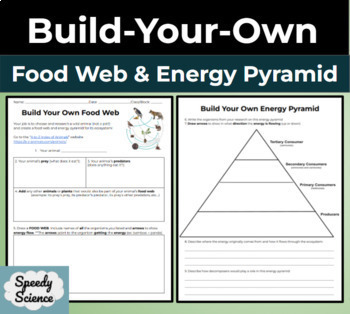Build Your Own Food Web and Energy Pyramid - Research Activity
Speedy Science
162 Followers
Grade Levels
4th - 12th
Subjects
Resource Type
Standards
NGSSMS-LS2-2
NGSSMS-LS2-3
Formats Included
- Google Docs™
Pages
2 pages
Speedy Science
162 Followers

Made for Google Drive™
This resource can be used by students on Google Drive or Google Classroom. To access this resource, you’ll need to allow TPT to add it to your Google Drive. See our FAQ and Privacy Policy for more information.
What educators are saying
This resource was very helpful for my students. I could edit the document to fit our food chain ecosystem boxes and students could use them to discuss when presenting. Students could work independently and still be on topic with what we are learning about in class.
My students loved this assignment. They worked in partners and learned some interesting things! They have now been asking to do more research! Thank you!
Description
Students research and create their own food web and energy pyramid based on an animal of their choice. This resource is editable via google docs, so you can either print directly or make edits to meet the needs of your students.
Great way to practice ecosystems concepts like energy flow, cycling of matter, tertiary, secondary, and primary consumers, predator, prey, carnivores, omnivores, herbivores, and decomposers.
"Your job is to choose and research a wild animal (not a pet!)
and create a food web and energy pyramid for its ecosystem!
Go to the “A to Z Index of Animals” website: https://a-z-animals.com/animals/"
Total Pages
2 pages
Answer Key
Not Included
Teaching Duration
N/A
Last updated Apr 7th, 2022
Report this resource to TPT
Reported resources will be reviewed by our team. Report this resource to let us know if this resource violates TPT’s content guidelines.
Standards
to see state-specific standards (only available in the US).
NGSSMS-LS2-2
Construct an explanation that predicts patterns of interactions among organisms across multiple ecosystems. Emphasis is on predicting consistent patterns of interactions in different ecosystems in terms of the relationships among and between organisms and abiotic components of ecosystems. Examples of types of interactions could include competitive, predatory, and mutually beneficial.
NGSSMS-LS2-3
Develop a model to describe the cycling of matter and flow of energy among living and nonliving parts of an ecosystem. Emphasis is on describing the conservation of matter and flow of energy into and out of various ecosystems, and on defining the boundaries of the system. Assessment does not include the use of chemical reactions to describe the processes.




